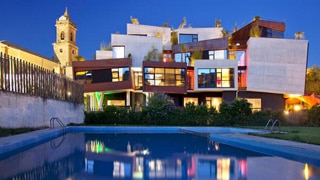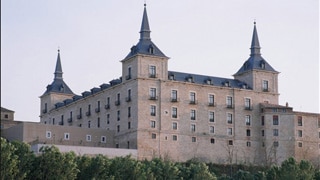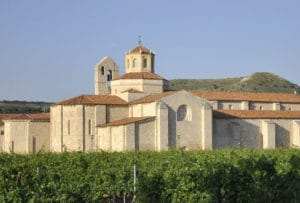We’d love to keep up with the pictures and videos from your fabulous bike tour!
Give us a follow on Instagram at @bikespaintours and tag us in the posts from your trip.
Your guide for this tour will be Yves: (+34) 651 90 46 53.
Call the Bike Spain Tours office on +34 915 590 653, or out of office hours call +34 677 356 586. We will get you where you need to be and get you the help you need.
Please be aware that Spaniards follow a very particular routine in terms of their daily meals, and this is often strictly enforced by restaurant opening hours, especially in small towns!
You can expect restaurants to be open for lunch from approximately 1:30pm – 4pm. Remember that lunch is the main meal of the day in Spain.
Dinnertime in Spain is any time from 8pm onwards. Dinner in Spain is typically a lighter meal.
Wednesday 8th and Thursday 9th May: Madrid
Accommodation: Own arrangements
At leisure in Madrid
Eating and drinking in Madrid
Friday, 10th May: Villabuena de Álava (Rioja)
Route: 26.6 km/16.6 miles
Elevation: +380 m/+1,246 ft
Accommodation: Hotel Viura
Meals included: Dinner
9:30am: Yves, your guide will pick you up from your hotel for your transfer to La Rioja.
On the way to La Rioja, we will stop off in the historic city of Burgos, which dates back to the 9th century, and is well-known for its UNESCO World Heritage Site Cathedral. You’ll enjoy some time at leisure in the city to stretch your legs and sample some excellent local tapas, before continuing the journey north.
Our first hotel is Hotel Viura, a luxury hotel set in its own vineyard. Once we’ve checked in, we’ll adjust the bikes and enjoy a short cycle loop around the local area to warm up your legs for the rest of the week! We’ll pass through the town of Elciego, where you’ll spot the unmistakable titanium waves of a Frank O. Gehry building. This is the famous Marques de Riscal hotel and winery and is worth visiting for its fabulous futuristic architecture alone.
In the evening, we’ll enjoy a gourmet dinner, paired with local Rioja wine.
At leisure in Villabuena de Álava
As with many other Riojan towns, much of the activity in Villabuena de Álava is connected with wine-making. In fact, it has more wineries per inhabitant than any other town in the world: one for every eight people!
Take a stroll aroung the historic centre and admire the stately homes, built in Rennaissance and Baroque styles: evidence of the wealth that wine production has brought to this small town over the centuries. Some notable examples are the Casa del Indiano and the Marquis of Solana.
If your legs are up to it after your cycle ride, a short walk from the town you can visit the El Montecillo Dolmen, a Bronze Age tomb discovered at the end of 2009 by a local inhabitant.
Saturday, 11th May: Villabuena de Alava (Rioja)
Route: 48.6 km/30.2 miles
Elevation: +728 m/+2,387 ft
Accommodation: Hotel Viura
Meals included: Breakfast and lunch
Today’s route follows small, quiet country paths along the Ebro River, giving you a chance to explore some of the area’s most beautiful and historic little towns.
You’ll discover, San Vicente de Sonsierra, a former fortress town where coats of arms still decorate historic palaces. Here, you can visit the medieval city centre, which boasts a castle, several watchtowers and the remains of the original city walls. You can also visit the 13th century church of San Juan de Arriba, which houses the nationally-famous Vera Cruz Brotherhood, who precede their Easter Week processions with self-flagellation to show their faith.
Your next stop will be Haro, one of La Rioja’s centres of wine production, and world-famous for the wine battle that takes place every June, in which locals and visitors alike attack each other with thousands of litres of wine!
Haro itself is a fascinating town, and it’s well worth taking a stroll to discover the sculptures of ordinary inhabitants performing traditional tasks, many of which are, of course, related to winemaking! We also recommend a visit to the Baroque Basilica, and a walk around the palaces of the old town.
Next, we’ll enjoy a delicious lunch at one of the region’s best wineries, paired with wines produced and bottled in-house.
1pm: Lunch at Bodegas Bai Gorri.
Optionally, after lunch, you can go to the Spa Marqués de Riscal in Elciego, a great place to rest and enjoy the sensations and revitalizing properties of the grape. Prior booking is essential, so please let us know in advance if you would like us to book any treatments for you.
In the afternoon, you will travel in the van to the charming little city of Laguardia, the fortified medieval capital of the Rioja Alava. Many of the town’s 320 wine cellars, which date back from the late 18th century, are still functioning today. As you approach, the town looks like something plucked straight from a fairytale: standing atop a hill, still partly surrounded by walls, towers and fortified getaways.
Tonight, dinner is not included in your tour package, so you can explore Laguardia and have dinner at your leisure. Our recommendation is the beautiful Restaurante Los Parajes; let us know if you would like us to reserve a table for you.
Sunday, 12th May: Lerma (Burgos)
Route: 41.9km/26 miles
Elevation: +651 m/+2,137 ft
Accommodation: Parador de Lerma
Meals included: Breakfast, lunch and dinner
Today, we’ll leave La Rioja behind, and discover our next Protected Denomination of Origin wine region: La Ribera del Duero!
You’ll pass through San Vicente de Sonsierra and into the atmospheric hilltop town of Briones, whose north side overlooks the River Ebro. In Briones, we also recommend a stroll around the town’s charming medieval centre, and a visit to the majestic 16th century Parroquia de Nuestra Señora de la Asunción.
From Briones, you’ll continue south towards Cañas, where we can see the imposing 12th century Monastery of Santa Maria de San Salvador.
From Cañas, we’ll head south to the town of San Millán de Cogolla, considered to be the cradle of the Spanish language, thanks to the influence of the Yuso (lower) and Suso (mountainside) monasteries. The monks worked for almost a hundred years to create the first comprehensive Spanish grammar and the two spectacular monasteries are now UNESCO World Heritage Sites. We’ll stop here to enjoy a delicious lunch in beautiful surroundings.
After lunch, our van will take us to the historic town of Lerma, in the Ribera del Duero wine region, where we’ll stay in the hilltop Ducal Palace, which once played host to Napoleon!
Tonight, we’ll enjoy a dinner ot traditional Castilian fare at the hotel restaurant.
At leisure in Lerma
Other than the Ducal Palace, the most important historic building in Lerma is the Collegiate Church of San Pedro, dating from the early 17th century, which is connected to the Ducal Palace by an elevated passageway and offers beautiful views of the River Arlanza. The town also boasts numerous monasteries, evidence of its historic importance.
Monday, 13th May: Valbuena
Route: 44.6 km/27.7 miles
Elevation: +459 m/+1507 ft
Accommodation: Castilla termal Valbuena SPA
Meals included: Breakfast, lunch and dinner
After breakfast, we’ll have a short drive to Santo Domingo de Silos, famous for its 12th century monastery, which boasts a beautiful Romanesque cloister. The monastery became famous all over the world when the first CD of Gregorian chants was recorded there.
From here, we’ll begin a charming route through the Ribera del Duero, cycling through vineyards and countryside towards the beautiful medieval village of Peñaranda de Duero, dominated by its imposing castle and boasting a well-preserved medieval town square. The town is situated on the Ribera del Duero wine route, and wines produced here are famous world-wide.
Next, we’ll continue cycling south all the way to the Duero river, where we’ll have lunch at a traditional local winery, set in the cellars of a former 15th century bodega.
2:30pm: Lunch at Casona de la Vid and guided tour and tasting at Lagar de Isilla.
We’ll spend the night in one of the best-preserved 12th century Cistercian monasteries in Europe. Overlooking the Duero River, the views from the hotel stretch across over the surrounding vineyards and countryside.
Tonight, we’ll enjoy a delicious dinner at the hotel, paired with excellent locally-produced wines.
At leisure in Valbuena
As early as the 12th century, the Cistercian monks discovered water-bearing rock deep below the surface, whose mineral-medicinal waters were used to irrigate their countryside and vineyards. Almost ten centuries later, the hotel continues to employ these thermal waters in their in-house spa.
Tuesday, 14th May: Valbuena (Burgos)
Route: 60.6 km/37.6 miles
Elevation: +455 m/+1493 ft
Accommodation: Castilla termal Valbuena SPA
Meals included: Breakfast, lunch and dinner
Today’s route takes us through some of through the oldest vineyards of Ribera del Duero. We’ll visit the town of Pesquera del Duero, known for growing some of the best grapes in the region, and dedicated almost exclusively to wine production. The historic old town features a beautiful porticoed Plaza Mayor, as well as numerous palaces, decorated with the family crests of the aristocrats of centuries gone by.
Next, we’ll follow the course of the Duero river to the historic fortified town of Peñafiel, one of the region’s centres of wine production. The town’s castle, the oldest part of which dates back to the 9th century, has been repurposed into a Wine Museum. We’ll take a stroll around the winding streets of the historic Jewish Quarter, and visit the charming Plaza del Coso, which retains its original traditional wooden balconies. During the summer, the square fulfils its original medieval function as the town bullring. We’ll enjoy lunch in Peñafiel before returning to our hotel by van.
7pm: A 55-minute massage has been booked for you at the hotel spa. Please note that this service is payable upon arrival at the hotel.
Tonight, we’ll head to a nearby town to enjoy a gourmet dinner of traditional fare in a refurbished historic windmill.
Wednesday, 15th May: Madrid
Route: 50.5 km/31.4 miles
Elevation: +685 m/+2247 ft
Accommodation: Own arrangements
Meals included: Breakfast, lunch and dinner
After breakfast, we’ll travel by van to the town of Ortigosa del Monte, from where we’ll begin our final cycle route. We’ll discover the Palacio Real de Riofrío, constructed in the 18th century and still in use today by the Spanish Royal family. The palace is surrounded by some 600 hectares of forest, making for a very pleasant cycle ride.
Next, we’ll pass through the beautiful mountain village of Valsaín, where the Spanish kings used to hunt in centuries gone by, before continuing on to the majestic Palacio Real de La Granja de San Ildefonso, another official residence of the Spanish Royal family. The Palace is surrounded by expansive gardens, which are considered to be one of the best examples of 18th century landscaping in Europe.
Finally, we’ll swap wine for whiskey with a visit to one of Spain’s few whiskey distilleries, before finishing the route in the UNESCO World Heritage city of Segovia. Here, we can visit the impressive Roman acqueduct, which was in use from the first century AD up to 1973; the enormous Gothic Cathedral; and the Alcázar Castle, said to have inspired Walt Disney!
After lunch in Segovia, we’ll continue to Madrid by van.
In the evening we’ll enjoy a farewell dinner, as well as a fiery flamenco show. ¡Olé!
9:30pm: Dinner and flamenco show at Tablao Las Carboneras.
Thursday, May 16th: Departure
Meals included: Breakfast
After breakfast, our services come to an end.
We hope that you enjoyed discovering Spain’s wine country with us!
Hotel Viura

The design hotel Viura is a tourist attraction on itself, with its ultramodern architecture surrounded by ancient buildings.
The name of this hotel comes from the most planted white grape in Rioja, which is the Viura grape. All rooms are spacious with a modern design, offering a great view on the surrounding buildings and the countryside in the distance. Delightful dinners are offered in the restaurant, based on Riojan and Basque cuisine and accompanied by local wines.
Hotel Parador de Lerma

The amazing ducal palace at Lerma, now a Parador, is located in the upper part of the city.
The hotel features a central courtyard surrounded by lovely columned galleries. The elegant majesty of this palace from the era of the Hapsburgs and its lovely interiors, with beautifully designed lighting and décor, will make your stay an unforgettable experience.
Castilla Termal Monasterio de Valbuena

Right at the heart of Ribera del Duero, this hotel – the first spa with 5 stars status in Castilla y León – is located in one the best preserved Cistercian monastery of the 12thcentury in Europe.
The Monastery of Santa María de Valbuena provides 79 rooms, all of them of high quality, a spa centre and hot spring bath, an outdoor pool, children’s playground and terrace.
To check the weather before you leave on your trip, please take a look at current weather conditions at www.weatheronline.co.uk. For historical temperature and precipitation statistics visit www.weatherbase.com or take a look at the Spanish Meteorological website with detailed information per region (http://www.aemet.es/en/elclima/datosclimatologicos/valoresclimatologicos)
The history of Spain is a compendium of influences from the different cultures that have lived in the country. The first settlers on the Peninsula were the Celts and the Iberians. The Roman presence in Hispania lasted for seven centuries, during which time the basic borders of the Peninsula in relation to other European towns were set up. Many institutions were inherited from Rome such as the concept of family, Latin as a language, religion and law. At the start of the 5th century new settlers from the North arrived and settled on the Peninsula: the Visigoths in the interior and the Swabians on the West. The decomposition of the Visigoth state apparatus would lead to the successive infiltration of Arab and Berber troops from the other side of the Straits of Gibraltar at the beginning of the 8th century. In the middle of the 8th century the Muslims had completed occupation and Cordoba became the center of the flourishing Andalusian state. The Arab presence in Spain would last for almost seven centuries and leave an indelible mark on the Spanish cultural heritage.
Following a long period of peaceful coexistence, the small Christian strongholds in the North of the Peninsula took on a leading role in the Reconquest, which ended with the capture of Granada in 1492 under the reign of the Catholic King and Queen, traditionally considered the founders of peninsular unity and the imperial management of the Spanish revival. The 16th century represents the zenith of Spanish hegemony in the world, a process that would last until the middle of the 17th century. Following the death of Charles II, the last of the Austrians, who died without having had children, Phillip V inaugurated the dynasty of the Bourbons of Spain.
The crisis of the Old Order opened the doorway to the Napoleonic invasion. The War of Independence was a war against the French invasion, but also a revolutionary war due to the decisive involvement of the people and the clear formation of a national consciousness that would later shape the 1812 Constitution. The Courts of Cadiz thereby enacted one of the first Constitutions of the world which ratified that sovereignty would reside in the nation. The conflict between liberalists and absolutists, or in other words, between two different ways of perceiving the establishment of the state, would be one of the longest Spanish conflicts throughout the 19th century.
The ballot box is introduced into Spain and with it the first democratic experience of the 20th century: the second Republic, a brief attempt to introduce the reformations the country needed, frustrated by General Franco’s military rising and the outbreak of the Civil War in 1936. The military victory of General Franco gave way to a long dictatorial period that would last until 1975. Following his death, the Spanish peacefully made the transition from dictatorship to democracy in a process known as ‘the Spanish model’. Don Juan Carlos I, as King of the Spanish people, became the chief of a social and democratic state of law, which molded the Constitution of 1978.
More information…? Should you be interested in a specific theme, please check here, you will find many info about culture, environmental issues, nature, society, geography and politics.
In Spain you have exquisite and innovative dishes with the guarantee of internationally prestigious chefs. The highest quality products from the best producers, recipes combining popular tradition with artistic creation and offer you exciting, new flavors. Spain’s culinary revolution, headed by master chefs like Ferrán Adriá, Arzak and Berasategui turns the pleasure of good food into a luxury for the senses that is at its finest when savored in Spain.
Spanish cuisine is nowadays recommended in the finest restaurants, heralded by the most prestigious critics and demanded by millions of consumers over the world. It has gone through a real revolution, which, in the time of a few short years, has put Spain at the top of international cuisine. With traditional styles as the basis, a modern, innovative cuisine has developed, identified by the use of quality products and by the creativity of its chefs.
To read more about Spain’s cuisine
Info
About UsContact Info
Plaza de la Villa 1,
28005 Madrid
+34 915 590 653
info@bikespain.com
